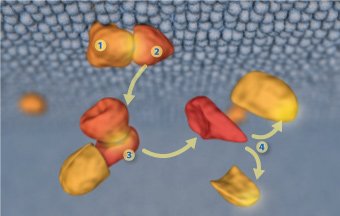Signals Travel Into Cells
Cells communicate by sending and receiving signals. Signals may come from the environment, or they may come from other cells. In order to trigger a response, these signals must be transmitted across the cell membrane. Sometimes the signal itself can cross the membrane. Other times the signal works by interacting with receptor proteins that contact both the outside and inside of the cell. In this case, only cells that have the correct receptors on their surfaces will respond to the signal.
Many signals are transmitted into a cell by first binding to a receptor protein. Here a signal (yellow) activates a receptor (orange) by causing it to change shape, thereby passing information into the cell.


